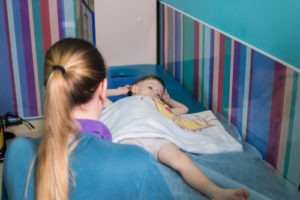
Cerebral palsy is a very common motor disability for children and newborns. The medical costs of children with cerebral palsy can be 10 times higher than those for children without cerebral palsy. Matters are made worse by the fact that other illnesses accompany cerebral palsy, such as epilepsy and intellectual disabilities. In such cases, the care costs can balloon to 26 times the average care costs of children who are born healthy.

These costs have been estimated to reach over $1 million over the course of the affected individual’s life and can easily outstrip the financial resources of a family. Call us today for a free consultation with Texas cerebral palsy lawyer.
Types of Cerebral Palsy
There are three broad categories of cerebral palsy. Each type has its own set of signs and symptoms. Your child’s doctor will be able to determine the correct course of treatment and rehabilitation for your child, but only after he or she has diagnosed your child as suffering from one of the three types of palsy below.
Spastic Cerebral Palsy
This palsy is the most commonly occurring type of cerebral palsy, and it affects 77.4% of all patients. It results in stiff muscles, leading to awkward movements. It can affect the legs only, one side of the body only, or all four limbs, including the face. Serious cases can leave an individual bedridden and may present with other illnesses such as seizures, developmental lags, and issues with vision, hearing, and speaking.
Dyskinetic Cerebral Palsy
Uncontrollable movements characterize this type of cerebral palsy. People who suffer this type of cerebral palsy have issues controlling their hands, arms, feet, and legs. This palsy makes it hard for them to walk and sit. Their movements can be uncontrollable and either slow or jerky. They may also have difficulty speaking and swallowing.
Ataxic Cerebral Palsy
This type of cerebral palsy is characterized by poor balance and coordination. The children tend to be unsteady when they walk and can have difficulty making quick movements or movements that require a great deal of control, such as writing.
Cerebral palsy may occur naturally as a result of, for example, genetic mutations or congenital abnormalities in the brain. Other causes may be physical trauma to the baby’s brain by the delivery team or even misdiagnosis of other issues. In cases that involve preventable birth injuries or actions that the delivery team could have or should have taken to safeguard the health and well-being of the baby but neglected to do so, an Arlington cerebral palsy lawyer can help you determine liability for damages and your best course of action.
For assistance understanding your legal options, call the Birth Injury Lawyers Group today at (800) 222-9529. The initial consultation is free.
"If your child was born with a birth injury, or cerebral palsy, we can help."
Signs and Symptoms of Cerebral Palsy
Because there are so many different levels and types of disability associated with cerebral palsy, there is no single defined set of issues that indicate the presence or absence of the illness. The most telling indication that a child has cerebral palsy is if he or she missed developmental milestones of some sort, such as sitting, standing, or crawling.
The signs below may indicate that a child has cerebral palsy, although it is important for parents and doctors to recognize that children who do not have cerebral palsy may also have some of these signs:
- He or she does not raise the head when picked up from the floor
- Stiff or floppy muscles
- An inability to roll over
- An inability to bring the hands together
- Difficulty bringing the hands to the mouth
- Lopsided crawling
- Scooting on the buttocks without crawling on all fours
Arlington Cerebral Palsy Lawyer Near Me (800) 222-9529
Diagnosis and Treatments for Cerebral Palsy
An early diagnosis and treatment of cerebral palsy are imperative if you are to put your child on a rehabilitative or therapeutic regimen that can help him or her overcome the disabilities he or she faces.
To diagnose cerebral palsy, your doctor may perform one or more of the following:
- Developmental monitoring to track the child’s development over time
- Developmental screening to test for developmental delays
- Developmental evaluations to diagnose specific disorders
- Diagnostic tests, such as MRIs or CT scans to identify brain damage
There is no cure for cerebral palsy because the types of brain damage that cause it are permanent, making the condition itself permanent as well. However, with treatment, the affected individual may be able to cope with and overcome some of the symptoms and disabilities he or she faces.
Treatment interventions include medicine, surgery, the use of assistive devices, and therapy in the form of physical or occupational. You should consult with your doctor about your child’s needs and the types of treatment best suited to his or her unique set of circumstances.
"We know first-hand what you are going through."
Legal Assistance in Cerebral Palsy Cases
You have to live with the treatment costs of cerebral palsy irrespective of how it developed. However, in cases involving medical malpractice, it is grossly unfair for you and your family to have to face the financial costs—not to mention the physical injuries of your child and the social and emotional trauma of living with cerebral palsy—if the injuries in question should not have occurred in the first place.
This is where an Arlington cerebral palsy lawyer can help. Call the Birth Injury Lawyers Group at (800) 222-9529 to learn more about how to determine the cause and prove liability for avoidable birth injuries so that you are not left with treatment costs for an illness your family should not have been made to suffer. We pride ourselves on no win, no fee services. Pay only when we win your case. Let us handle your case for you so you can focus on caring for your injured love one. Call now, because the statutes of limitation for medical malpractice under Texas Statutes Chapter 74 may expire sooner than you realize.
"We are committed to helping families who have suffered medical negligence."
